(The 95 Theses on Painting)
1. I am a painter.
2. I decided to become a painter. No one asked me to do this.
3. Becoming a painter is my way of deciphering the codes of visual information and experience that structure capitalism in our time.
4. Deciphering the codes also means rethinking the implied values of those codes.
5. I was never a doodler. (I never drew idly, playfully, without self-judgment and insecurity, for fun. Even as a small child I broke crayons from pressing too hard, and learned quickly that my artistic efforts would be judged harshly.)
6. I was not told I had artistic potential.
7. I am a 37 year old woman with no children and no intention of having children. The significance of this decision is simply that my investment in the future is necessarily different, less personal. I do not have children, but I do have students. I worry for them. I wonder what kind of a world they are growing up into. What they understand of the world and what they will make of their understanding.
8. Painting is an activity that takes place within quotidian time, and has the ability to expand and transform clock time beyond the everyday, toward the eternal.
9. This movement toward the eternal has been critiqued as Romantic, but is as realist and banal as keeping one’s hands in warm dishwater on a sunny afternoon. The decision to space out – to get lost in a moment is an always available decision.
10. My paintings do not have value because they are in the museum. They have value because they are in dialogue with and a continuation of other paintings.
11. This dialogue involves careful looking at and questioning of paintings in museums, in studios, in galleries, in homes, and response in my own work, sometimes pictured as thrashing, flailing argument, sometimes illustrative, sometimes critically dialectical and sometimes dreamily intuitive.
12. I believe in painting as a meaningful act.
13. I believe in painting as a desperate, stupid, time-wasting act involving huge, crippling ambition and necessary and near-constant failure. This too is meaningful.
14. To fail interestingly one must understand the stakes of one’s endeavor and try to achieve something against certain odds.
15. The stakes of painting are both universal and personal.
16. The history of painting is parallel to, and provides a bodily, always-contemporary narrative of the history of civilization.
17. To make paintings one must take seriously the triumph and tragedy of civilization.
18. The continuation of civilization belongs to anyone who has the courage to imagine herself an implicated participant in its history.
19. To make an important painting one must posit oneself as a person of consequence.
20. A person of consequence tries to understand the possible effects of her actions.
21. I know what I do, but I do not know what what I do, does.
22. One of the tragedies of civilization is that we have believed and continue to believe that one is born into the position of being a person of consequence.
23. Understanding the unruly effects of one’s actions as an individual enmeshed in a complex global situation is impossible and thus one must constantly reconcile oneself to the ruinous effects of most human endeavor.
24. I am aware that most of my action is harmful. (Richard Rorty’s definition of a liberal is someone who tried to do the least harm.)
25. Most human endeavors are enacted with the arrogance of a false person of consequence who believes that they do right.
26. A painter knows that to do no harm is impossible. (This knowledge is arrived at through the consistent experience of preparing a pure, white surface and muddying it, messing it up, adding and subtracting in a process of working out the drives to destroy and create, and the shame of these drives.)
27. A painter knows that civilization is untenable.
28. To stand up and assert oneself as a person of consequence is to assert a distrust in universal human values, (in ambivalent favor of the individual perspective) and the simultaneous necessity of continuing to teach and perform universal values as well as their critique in the hope of future generations finding better resolutions to impossible questions.
29. I often don’t know if I am whispering but should be yelling or vice versa. This is a painting problem.
30. Painting reminds me of my actual size.
31. For all of the above reasons, painting can be an avant-garde act.
32. In the past the avant-garde has tried to keep up with technological “progress” in an effort to critique it.
33. Today, the avant-garde has trouble locating itself or its purpose.
34. I believe the painter, contending with gravity, materiality, action and history, is best equipped to articulate the goals of the avant-garde.
35. The problem of attention is addressed by painting.
36. The problem of containment is located within painting.
37. The problem of time is felt in painting.
38. When I stand before a painting and am able to bring my whole self to the experience, I feel the arrested time, which is felt as my own death.
39. This is different from the experience of photography, which is also arrested time, but stopped by a mechanical or digital device.
40. The effort of the painter to stop time with her own hands, in the face of history, hurts more, but the pain is empowering, not debilitating.
41. Feeling one’s own death is the beginning of developing a sense of the consequences of one’s actions.
42. Painting at its best is utterly demanding, cruel, and hopeful.
43. A painting asserts its own criteria for success or failure. The painting itself tells you how it wishes to be judged.
44. Paintings ask for judgment. This is their gift. How do they do this?
45. They sit completely still.
46. Even when they attempt to ingratiate themselves, by trendy color or shiny surfaces, they carry the awareness of how short-lived their charms will be.
47. Janus-faced, paintings look backward and forward in perplexed, stony silence.
48. At times painting is passionately committed to its history, and sometimes, nostalgically resigned to its pastness, but always, painting looks backward.
49. Often painting is anticipatory, excitable, and enthusiastically bad, while being as present and happy to be here as a preteen at a slumber party, but always, painting looks forward.
50. Though strongly held positions may appear arrogant, dogmatic and single-minded, to adopt and substantiate a critical attitude is in fact the most humble of gestures since such positions pre-suppose their own negation.
51. Painting is a strongly held position.
52. The purpose of holding a strong position is to offer open invitation to dissenting critical thought.
53. The painter’s goal with respect to the future is to stay relevant without becoming absorbed.
54. This means keeping pace with (dirtying oneself on) the organizing forces of capitalism (social, economic) without giving into them. Ie not just being a symptom, but exercising discipline, moderation, restrained investment sometimes, and decadence, porosity, and the wild flail other times.
55. In painting, one has a conversation with oneself that is in some ways the same as the conversation with the world. The difference is similar to the distinction between speech and writing.
56. In speech, one cannot take something back.
57. In writing, one changes one’s mind privately, and presents a reasoned argument publicly.
58. In painting, the difference is that the accumulated evidence of changing one’s mind is allowed to remain as build-up, as density, or sedimentation.
59. This sedimentation is what I am calling human.
60. In relationships with others, this sedimentation is often heavy, angry, resentful. Things said and taken back reside in memory and are not easily discharged.
61. In a painting practice, this long conversation with the self (which is a conversation with all the others encountered in one’s life, and internalized,) is manifest, present in time and space as a whole, as an alternate body: the body of work.
62. The body of work is evidence of the work of living.
63. The work of living is different from making a living, which is obligatory, and a strange euphemism for the giving up of part of one’s life to the activity of paying for that life.
64. Painting is a paradoxically elite activity precisely because when fully engaged as a critical, lifelong practice, the painter gives up all of her life to this practice.
65. All work, including washing dishes, sewing clothing, devising advertising campaigns and building IPhones can be meaningful, but capitalism has chosen to segregate these practices into a hierarchy of value.
66. Work typically done by women, with the hands, is not valued.
67. Work done in factories, with machines and hands, now mainly in China, is not valued.
68. Work done in the home, such as washing dishes or raising children is not valued.
69. Work done on the farm, with machines and hands, is not valued.
70. We do not value work because we do not value ourselves. And we regard the objects made and lived with as depressed, depleted mirrors of our sorry self-hatred.
71. We then make up new/old categories such as artisanal, and make cocktails, handbags and nouveau cuisine for the wealthy as a compensatory gesture.
72. This does not compensate. Some people have lifestyle and many exist in poverty to support that lifestyle.
73. The dream of abstract painting in the 20th century was a dream of whole people, whose senses weren’t fragmented, whose vision was complete, who made paintings with their hearts and minds and bodies in harmony.
74. This dream is still a dream, not yet a reality, and ever-receding.
75. This dream is foolish and necessary, and the wholeness of its vision is what makes it foolish, and the wholeness of its vision is what makes it necessary.
76. Keeping a foolish dream alive makes one a fool.
77. Society has always needed fools: the fool is both self-electing and made from without, by the society.
78. The fool bears the shame of society’s fears. The fool is a scapegoat.
79. The painter today is a fool.
80. The painter today becomes familiar with shame. The hot flush of shame, the constriction of muscles, the desperate need to hide. The painter accepts these feelings and holds them, and smiles warmly.
81. The painter gives a gift that is unwanted and even hated.
82. The gift the painter gives is the very human meaning of engaging in a useless and unjustifiable activity.
83. It is simply this. There is no justification for what I do.
84. I’ll say it again. I do nothing useful to justify my existence, and yet I believe I deserve to exist. All life deserves this unjustified blessing.
85. Painting is an utterly useless activity.
86. And yet, painting gives my life meaning.
87. Painting is the language of form and space that reminds me that I am made of the same stuff as the world.
88. I am hard and soft, gentle and dense and dispersed, bright and sharp, contrasting and undulating, acidic and toxic and soothing. As is the world.
89. I paint to step away from myself and realize that I am one with myself.
90. I paint to step away from the world and realize that I am one with the world.
91. I paint to forget everything I know.
92. I paint to remember again, everything I dismembered, and to become a member of something new, which was there all along.
93. I choose, each time as though for the first time, to think and teach and write and love as a painter.
94. The movement through the 95 theses is an agonistic, difficult process I go through again and again, mostly forgetting that there is relief and containment at the end.
95. Painters make better lovers.
2. I decided to become a painter. No one asked me to do this.
3. Becoming a painter is my way of deciphering the codes of visual information and experience that structure capitalism in our time.
4. Deciphering the codes also means rethinking the implied values of those codes.
5. I was never a doodler. (I never drew idly, playfully, without self-judgment and insecurity, for fun. Even as a small child I broke crayons from pressing too hard, and learned quickly that my artistic efforts would be judged harshly.)
6. I was not told I had artistic potential.
7. I am a 37 year old woman with no children and no intention of having children. The significance of this decision is simply that my investment in the future is necessarily different, less personal. I do not have children, but I do have students. I worry for them. I wonder what kind of a world they are growing up into. What they understand of the world and what they will make of their understanding.
8. Painting is an activity that takes place within quotidian time, and has the ability to expand and transform clock time beyond the everyday, toward the eternal.
9. This movement toward the eternal has been critiqued as Romantic, but is as realist and banal as keeping one’s hands in warm dishwater on a sunny afternoon. The decision to space out – to get lost in a moment is an always available decision.
10. My paintings do not have value because they are in the museum. They have value because they are in dialogue with and a continuation of other paintings.
11. This dialogue involves careful looking at and questioning of paintings in museums, in studios, in galleries, in homes, and response in my own work, sometimes pictured as thrashing, flailing argument, sometimes illustrative, sometimes critically dialectical and sometimes dreamily intuitive.
12. I believe in painting as a meaningful act.
13. I believe in painting as a desperate, stupid, time-wasting act involving huge, crippling ambition and necessary and near-constant failure. This too is meaningful.
14. To fail interestingly one must understand the stakes of one’s endeavor and try to achieve something against certain odds.
15. The stakes of painting are both universal and personal.
16. The history of painting is parallel to, and provides a bodily, always-contemporary narrative of the history of civilization.
17. To make paintings one must take seriously the triumph and tragedy of civilization.
18. The continuation of civilization belongs to anyone who has the courage to imagine herself an implicated participant in its history.
19. To make an important painting one must posit oneself as a person of consequence.
20. A person of consequence tries to understand the possible effects of her actions.
21. I know what I do, but I do not know what what I do, does.
22. One of the tragedies of civilization is that we have believed and continue to believe that one is born into the position of being a person of consequence.
23. Understanding the unruly effects of one’s actions as an individual enmeshed in a complex global situation is impossible and thus one must constantly reconcile oneself to the ruinous effects of most human endeavor.
24. I am aware that most of my action is harmful. (Richard Rorty’s definition of a liberal is someone who tried to do the least harm.)
25. Most human endeavors are enacted with the arrogance of a false person of consequence who believes that they do right.
26. A painter knows that to do no harm is impossible. (This knowledge is arrived at through the consistent experience of preparing a pure, white surface and muddying it, messing it up, adding and subtracting in a process of working out the drives to destroy and create, and the shame of these drives.)
27. A painter knows that civilization is untenable.
28. To stand up and assert oneself as a person of consequence is to assert a distrust in universal human values, (in ambivalent favor of the individual perspective) and the simultaneous necessity of continuing to teach and perform universal values as well as their critique in the hope of future generations finding better resolutions to impossible questions.
29. I often don’t know if I am whispering but should be yelling or vice versa. This is a painting problem.
30. Painting reminds me of my actual size.
31. For all of the above reasons, painting can be an avant-garde act.
32. In the past the avant-garde has tried to keep up with technological “progress” in an effort to critique it.
33. Today, the avant-garde has trouble locating itself or its purpose.
34. I believe the painter, contending with gravity, materiality, action and history, is best equipped to articulate the goals of the avant-garde.
35. The problem of attention is addressed by painting.
36. The problem of containment is located within painting.
37. The problem of time is felt in painting.
38. When I stand before a painting and am able to bring my whole self to the experience, I feel the arrested time, which is felt as my own death.
39. This is different from the experience of photography, which is also arrested time, but stopped by a mechanical or digital device.
40. The effort of the painter to stop time with her own hands, in the face of history, hurts more, but the pain is empowering, not debilitating.
41. Feeling one’s own death is the beginning of developing a sense of the consequences of one’s actions.
42. Painting at its best is utterly demanding, cruel, and hopeful.
43. A painting asserts its own criteria for success or failure. The painting itself tells you how it wishes to be judged.
44. Paintings ask for judgment. This is their gift. How do they do this?
45. They sit completely still.
46. Even when they attempt to ingratiate themselves, by trendy color or shiny surfaces, they carry the awareness of how short-lived their charms will be.
47. Janus-faced, paintings look backward and forward in perplexed, stony silence.
48. At times painting is passionately committed to its history, and sometimes, nostalgically resigned to its pastness, but always, painting looks backward.
49. Often painting is anticipatory, excitable, and enthusiastically bad, while being as present and happy to be here as a preteen at a slumber party, but always, painting looks forward.
50. Though strongly held positions may appear arrogant, dogmatic and single-minded, to adopt and substantiate a critical attitude is in fact the most humble of gestures since such positions pre-suppose their own negation.
51. Painting is a strongly held position.
52. The purpose of holding a strong position is to offer open invitation to dissenting critical thought.
53. The painter’s goal with respect to the future is to stay relevant without becoming absorbed.
54. This means keeping pace with (dirtying oneself on) the organizing forces of capitalism (social, economic) without giving into them. Ie not just being a symptom, but exercising discipline, moderation, restrained investment sometimes, and decadence, porosity, and the wild flail other times.
55. In painting, one has a conversation with oneself that is in some ways the same as the conversation with the world. The difference is similar to the distinction between speech and writing.
56. In speech, one cannot take something back.
57. In writing, one changes one’s mind privately, and presents a reasoned argument publicly.
58. In painting, the difference is that the accumulated evidence of changing one’s mind is allowed to remain as build-up, as density, or sedimentation.
59. This sedimentation is what I am calling human.
60. In relationships with others, this sedimentation is often heavy, angry, resentful. Things said and taken back reside in memory and are not easily discharged.
61. In a painting practice, this long conversation with the self (which is a conversation with all the others encountered in one’s life, and internalized,) is manifest, present in time and space as a whole, as an alternate body: the body of work.
62. The body of work is evidence of the work of living.
63. The work of living is different from making a living, which is obligatory, and a strange euphemism for the giving up of part of one’s life to the activity of paying for that life.
64. Painting is a paradoxically elite activity precisely because when fully engaged as a critical, lifelong practice, the painter gives up all of her life to this practice.
65. All work, including washing dishes, sewing clothing, devising advertising campaigns and building IPhones can be meaningful, but capitalism has chosen to segregate these practices into a hierarchy of value.
66. Work typically done by women, with the hands, is not valued.
67. Work done in factories, with machines and hands, now mainly in China, is not valued.
68. Work done in the home, such as washing dishes or raising children is not valued.
69. Work done on the farm, with machines and hands, is not valued.
70. We do not value work because we do not value ourselves. And we regard the objects made and lived with as depressed, depleted mirrors of our sorry self-hatred.
71. We then make up new/old categories such as artisanal, and make cocktails, handbags and nouveau cuisine for the wealthy as a compensatory gesture.
72. This does not compensate. Some people have lifestyle and many exist in poverty to support that lifestyle.
73. The dream of abstract painting in the 20th century was a dream of whole people, whose senses weren’t fragmented, whose vision was complete, who made paintings with their hearts and minds and bodies in harmony.
74. This dream is still a dream, not yet a reality, and ever-receding.
75. This dream is foolish and necessary, and the wholeness of its vision is what makes it foolish, and the wholeness of its vision is what makes it necessary.
76. Keeping a foolish dream alive makes one a fool.
77. Society has always needed fools: the fool is both self-electing and made from without, by the society.
78. The fool bears the shame of society’s fears. The fool is a scapegoat.
79. The painter today is a fool.
80. The painter today becomes familiar with shame. The hot flush of shame, the constriction of muscles, the desperate need to hide. The painter accepts these feelings and holds them, and smiles warmly.
81. The painter gives a gift that is unwanted and even hated.
82. The gift the painter gives is the very human meaning of engaging in a useless and unjustifiable activity.
83. It is simply this. There is no justification for what I do.
84. I’ll say it again. I do nothing useful to justify my existence, and yet I believe I deserve to exist. All life deserves this unjustified blessing.
85. Painting is an utterly useless activity.
86. And yet, painting gives my life meaning.
87. Painting is the language of form and space that reminds me that I am made of the same stuff as the world.
88. I am hard and soft, gentle and dense and dispersed, bright and sharp, contrasting and undulating, acidic and toxic and soothing. As is the world.
89. I paint to step away from myself and realize that I am one with myself.
90. I paint to step away from the world and realize that I am one with the world.
91. I paint to forget everything I know.
92. I paint to remember again, everything I dismembered, and to become a member of something new, which was there all along.
93. I choose, each time as though for the first time, to think and teach and write and love as a painter.
94. The movement through the 95 theses is an agonistic, difficult process I go through again and again, mostly forgetting that there is relief and containment at the end.
95. Painters make better lovers.
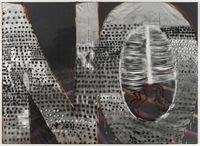 |
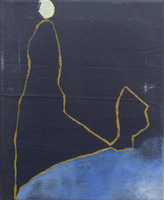 |
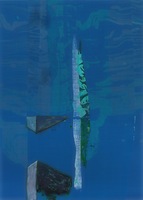 |
 |
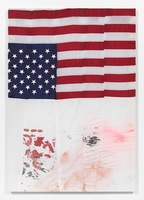 |
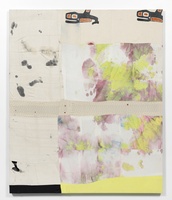 |
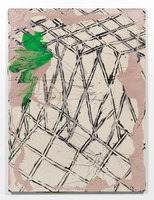 |
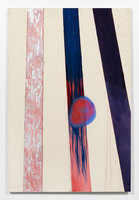 |
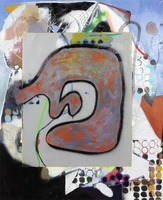 |
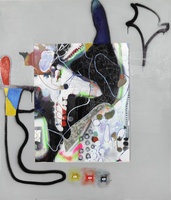 | ||
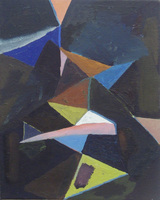 |
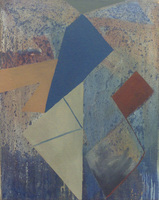 |
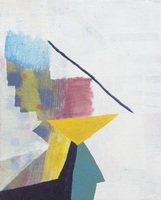 |
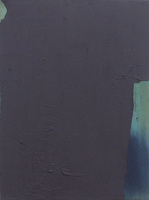 |
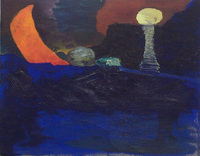 |
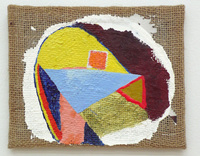 |
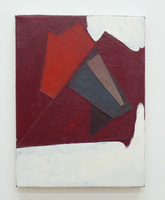 |
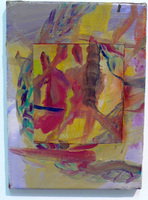 |
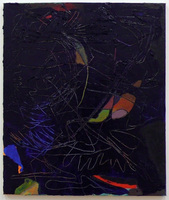 |
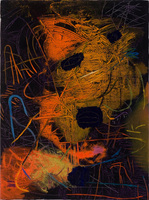 |
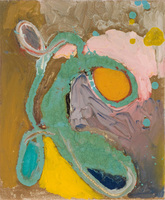 |
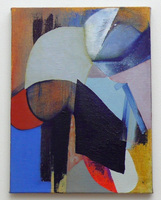 |
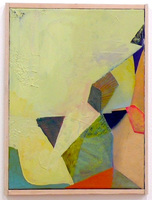 |
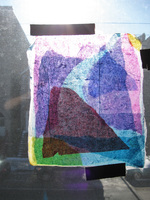 |
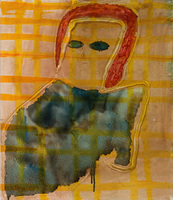 |
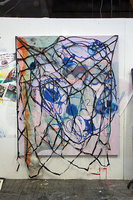 |
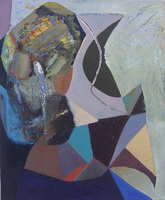 |
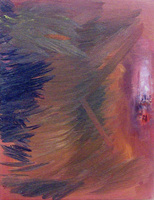 |
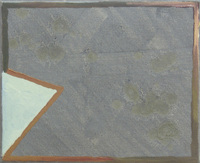 | |
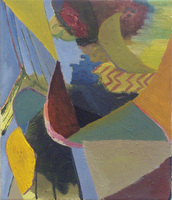 |
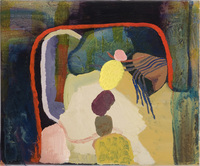 |
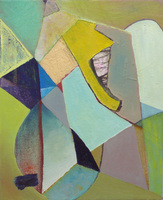 |
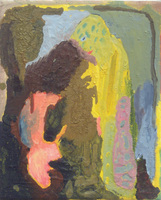 |
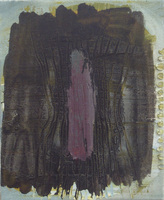 |
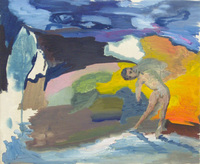 |